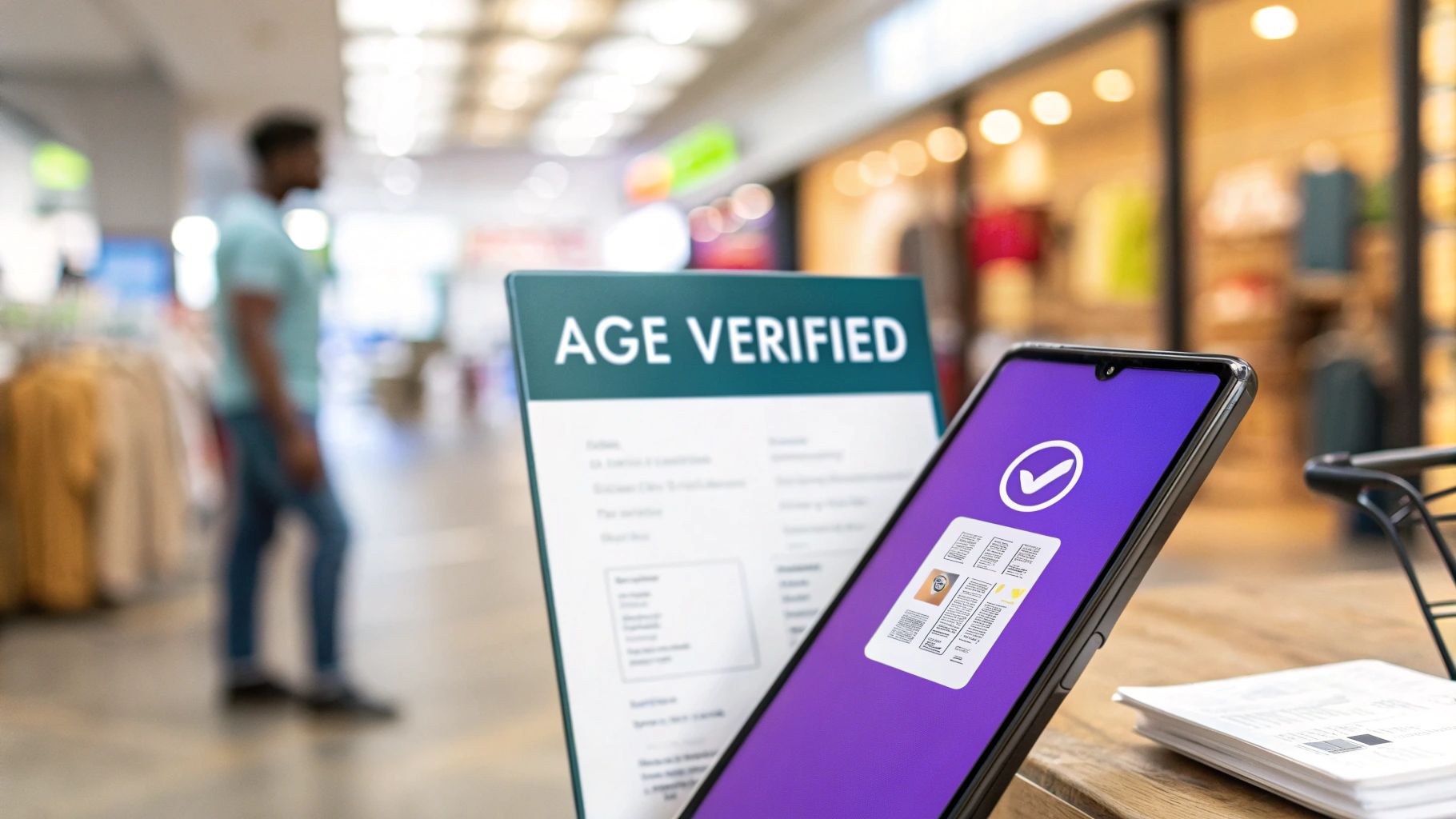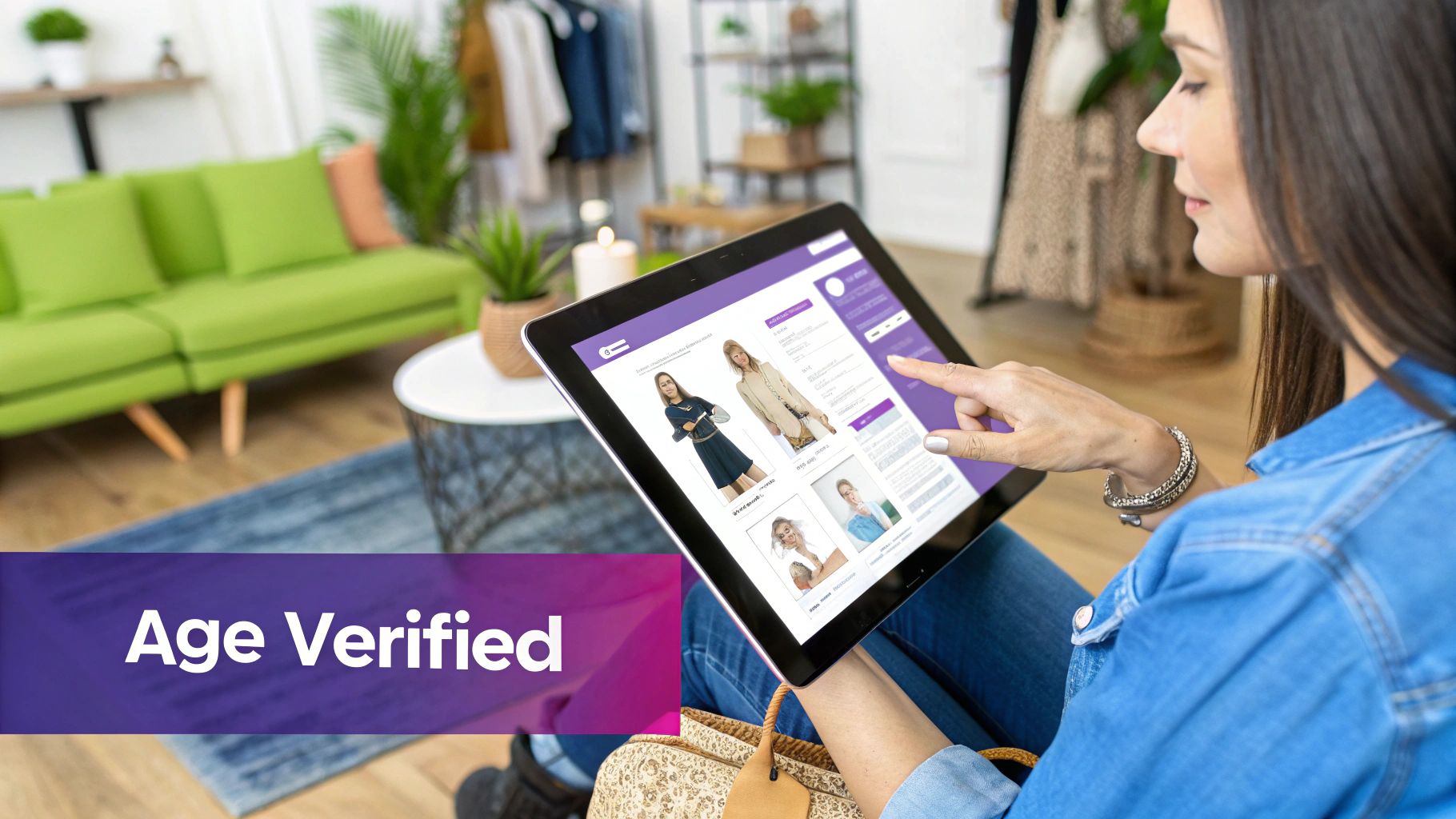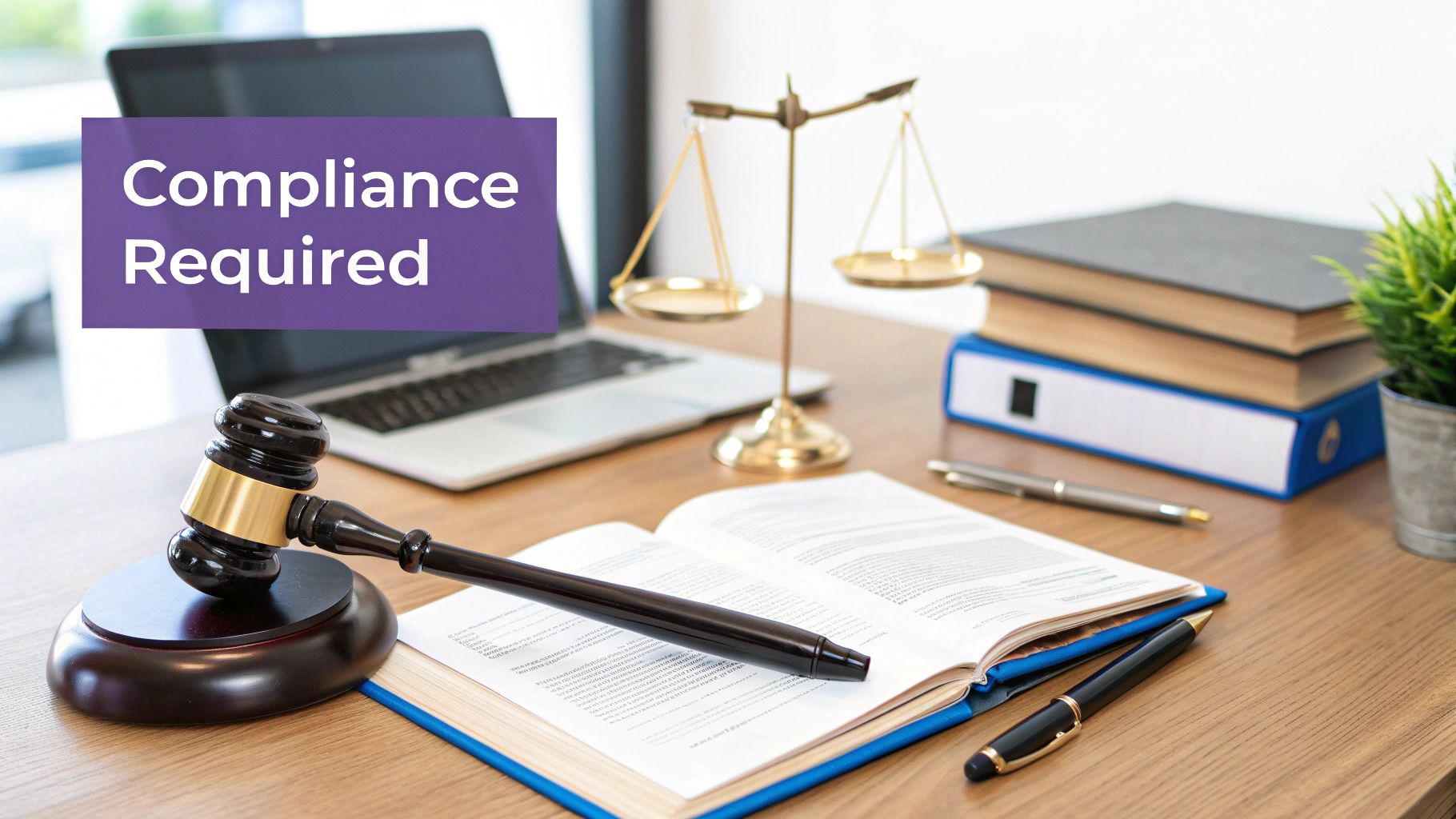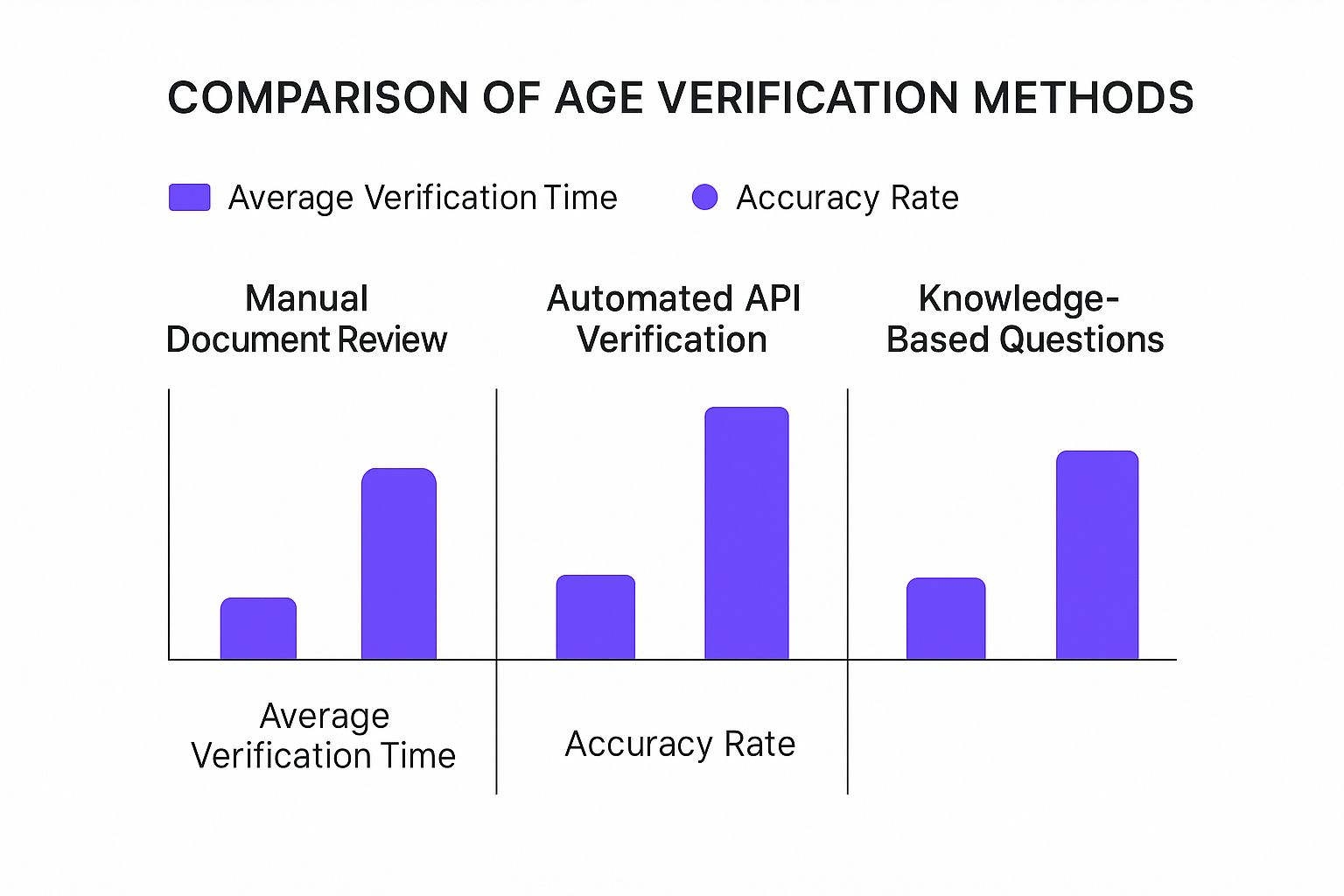
Age Verification for Online Sales: Best Practices for Regulated Products
Learn essential age verification for online sales. Our guide covers best practices, legal requirements, and tools for regulated products compliance.
Cody Y.
Updated on Sep 28, 2025
Think of age verification for online sales as your store's digital bouncer. It’s not just a box to check; it’s the frontline defense protecting your business from some very real legal and financial trouble. Getting this right is about more than just compliance—it’s about safeguarding your brand, sidestepping massive fines, and holding onto your payment processing accounts.
Why Age Verification Is a Digital Bouncer for Your Store
A solid age verification system isn't a barrier for your customers; it's a critical security measure for your online store. If you're selling regulated goods on a platform like WooCommerce, a misstep here can be catastrophic. One slip-up could lead to crippling fines, the loss of your merchant account, and a hit to your reputation that’s hard to come back from.
This isn't a niche problem anymore. More and more online businesses are finding themselves in this boat. The real trick is to walk the line between ironclad compliance and a smooth, frustration-free customer experience. A clunky, confusing verification process will send shoppers running for the hills, and that's the last thing you want.
The Stakes of Non-Compliance
The need for dependable age verification is blowing up. The global market for these kinds of solutions was recently valued around USD 2.5 billion and is expected to rocket to USD 7.1 billion by 2033. That explosive growth tells you everything you need to know about the pressure businesses are under to get their act together.
This "digital bouncer" is absolutely essential, especially with growing concerns about marketing regulated products to youngsters. It’s all about selling responsibly and staying on the right side of the law.
Who Needs Age Verification
A whole host of industries now rely on accurate age verification just to operate legally. This isn't just for a few obscure online shops; it's become standard practice for many mainstream ecommerce businesses.
- Alcohol and Tobacco: This is the big one. Online sales are governed by a complex web of federal and state laws that you can't afford to ignore.
- Vaping and E-Cigarettes: These products are under a microscope, and that means the age checks have to be airtight.
- CBD and Cannabis Products: As legalization spreads, so do the strict compliance rules for anyone selling online.
- Online Gaming and Gambling: It's absolutely crucial to verify a user's age to keep minors out.
- Adult Content: Access to any explicit material has to be strictly limited to adults.
The great thing about WooCommerce is its flexibility—it can power all sorts of stores, including those in heavily regulated industries.

If you want to get into the nitty-gritty of specific product categories, our guide on managing shipments for different age-restricted industries is a great resource. It quickly becomes clear that a cookie-cutter solution won't cut it. Your strategy has to be tailored to what you sell and the specific laws you have to follow.
Navigating the Complex Legal Landscape
Selling regulated products online isn't as simple as setting up a shop and watching the orders roll in. You're stepping into a world with a patchwork of laws, not a single, universal rulebook. The rules for age verification for online sales can shift dramatically based on what you sell, where your customer lives, and even the current political winds. It's a tricky environment where a one-size-fits-all approach just doesn't cut it.
Take vape products in the United States, for example. At a minimum, sellers have to deal with the federal PACT Act, which has its own strict set of rules for shipping and reporting. But that's just the baseline. States often tack on their own requirements, creating a complex web of compliance that’s nearly impossible to navigate without the right strategy and tools. We've actually put together a guide specifically on this topic: PACT Act compliance for vape and tobacco shipping in Woo-commerce.

Understanding Your Due Diligence
In this legal maze, the concept of due diligence becomes your best defense. It's a legal term that basically means you can prove you took reasonable steps to prevent an illegal sale. It’s all about showing you weren't being careless.
Due diligence isn’t about being perfect; it’s about making a solid, commercially reasonable effort. A simple checkbox asking, "Are you over 21?" offers almost zero legal protection. On the other hand, a robust, multi-step verification process shows you're a responsible merchant.
This is huge. If an underage sale slips through, the first thing authorities will look at are the measures you had in place. A strong, defensible verification process can be the difference between a slap on the wrist and a fine that could shut you down. This is especially true for sensitive pharmaceuticals; selling erectile dysfunction treatments like Avarante 10mg tablets online, for instance, demands serious age checks to prevent sales to minors and confirm the buyer is suitable.
The Shifting Regulatory Sands
These legal requirements aren't set in stone—they're constantly changing. Think of it like shifting sands. Nearly half of all U.S. states now have laws requiring age verification for online adult content, and that number is growing.
Recent court rulings have upheld these state-level laws, which only encourages more states to jump on board. As the legal goalposts move, your business has to be ready to pivot. Keeping a proactive stance is the only way to stay ahead.
This means you need a clear game plan:
- Know the laws inside and out for your specific products and every region you sell to.
- Implement a verification method that’s strong enough to genuinely demonstrate due diligence.
- Stay informed about new legislation so your compliance processes don't become outdated.
Dropping the ball on any of these exposes your business to some serious risks. That’s why the best practices we're about to cover are so essential for your store's long-term health.
Choosing the Right Age Verification Method
Picking the right age verification system isn't just a technical decision—it's a critical business strategy. The method you choose directly affects your legal standing, your customer's shopping experience, and, ultimately, your bottom line. Think of it like choosing the right lock for your front door. A simple latch might keep an honest person out, but a deadbolt provides real security when it matters most.
The options for age verification for online sales run the gamut from simple, low-friction pop-ups to robust, multi-layered systems. The right choice for your business depends entirely on what you sell, the legal risks you carry, and your budget.
Low-Assurance Methods: Simple but Risky
The most basic approach is the self-declaration pop-up. You've seen it a thousand times: the simple "Are you over 21?" checkbox or dropdown menu. While it’s incredibly easy and cheap to add to your site, it offers almost zero genuine legal protection. It’s an honor system, which simply doesn’t cut it for high-risk products like alcohol, tobacco, or firearms.
Relying solely on self-declaration is like asking the fox to guard the henhouse. It might deter a few underage users, but it won't hold up for a second if an illegal sale traces back to you. This method is really only suitable for products with a very low-risk profile, where compliance is more of a formality than a strict legal requirement.
Medium-Assurance Methods: Finding a Balance
Moving up the ladder, we find methods that strike a much better balance between security and user convenience. These options perform a more substantial check without forcing customers to pull out their wallets and upload sensitive documents.
- Database Lookups: These systems take a customer’s name, address, and date of birth and cross-reference them against public or private databases (like credit bureaus or government records). It’s a fast, behind-the-scenes check that adds very little friction to the checkout process.
- Knowledge-Based Authentication (KBA): This is the classic "out-of-wallet" question method. It asks users questions that, in theory, only they should know the answer to, like "Which of these addresses have you previously lived at?" This adds another layer of identity confirmation.
These mid-tier methods show you're performing reasonable due diligence and are a massive improvement over a simple pop-up. They're a popular choice for industries like online gaming or certain CBD products, where a solid check is necessary but full ID scanning might be overkill.
The chart below shows just how much speed and accuracy can vary between different verification approaches.

As you can see, automated API verification delivers a result almost instantly with high accuracy, whereas manual reviews create a significant bottleneck.
High-Assurance Methods: The Gold Standard
When you’re selling highly regulated products, you need the strongest defense you can get. High-assurance methods provide the most robust verification possible and are widely considered the gold standard for compliance.
These advanced solutions create a clear, defensible audit trail. They prove you took every reasonable step to verify a customer’s age, which is your best protection against legal action and fines.
This top tier of verification includes:
- AI-Powered ID Scanning: Customers are prompted to upload a photo of their government-issued ID, like a driver's license. Sophisticated AI then analyzes the document to confirm its authenticity and extract the age data.
- Biometric Verification: This powerful method usually pairs ID scanning with a live selfie. The system uses facial recognition technology to match the person in the selfie to the photo on the ID, effectively stopping someone from using a stolen or borrowed document.
Yes, these methods introduce a bit more friction for the user, but they offer unmatched security and legal cover. For any business selling firearms, alcohol, or pharmaceuticals online, this level of verification isn't just a best practice—it's essential for survival.
To help you decide, let's break down the most common methods in a quick comparison.
Comparison of Age Verification Methods
| Method | Accuracy & Compliance | User Friction | Typical Cost | Best For |
|---|---|---|---|---|
| Self-Declaration | Very Low. Offers minimal legal protection. | Very Low. A single click. | Very Low / Free | Low-risk content (e.g., mature media, blogs) where compliance is a guideline, not a strict law. |
| Database/API Checks | High. Cross-references official records. | Low. Runs in the background with user-provided info. | Mid-Range (per check) | E-commerce with moderate risk, like vape products, CBD, or online gaming. |
| Knowledge-Based Q&A | Moderate. Deters casual attempts but can be bypassed. | Medium. Requires users to answer personal questions. | Mid-Range (per check) | An added layer of security for financial services or moderate-risk products. |
| ID Scan + Biometrics | Very High. The gold standard for legal defense. | High. Requires uploading documents and taking a selfie. | High (per check) | Highly regulated industries: alcohol, tobacco, firearms, pharmaceuticals, and age-restricted services. |
Ultimately, the goal is to choose a method that not only satisfies legal requirements but also aligns with your customers' expectations and your operational capabilities. For most regulated industries, a high-assurance method is the only truly safe bet.
Creating a Smooth and Compliant User Experience
Let’s be honest: age verification for online sales is a legal must-have, but it can also be a massive conversion killer. A clunky, confusing process is the fastest way to send potential customers running for the digital hills, leaving behind a full shopping cart. The real challenge, then, is to weave this necessary check into the customer journey so seamlessly that it feels less like a roadblock and more like a simple, reassuring step.
Put yourself in your customer's shoes for a moment. They've found what they want and they're ready to buy. The last thing they want is to be hit with a complicated, unexpected demand that interrupts their flow. Your goal is to make age verification feel like a natural part of the checkout process, not a sudden, jarring interrogation.
This is where smart, thoughtful design makes all the difference. When, where, and how you ask for verification can be the deciding factor between a completed sale and an abandoned cart.

Pinpointing the Right Moment for Verification
Timing is everything. Ask too early, and you might come off as aggressive. Ask too late, and you risk frustrating a customer who has already spent time and energy shopping on your site. Generally, you have three solid options for placing this crucial check:
- On Site Entry: This is the bouncer-at-the-door approach. An age gate on your homepage ensures every single visitor is of legal age before they can even start browsing. It's the go-to method for stores where 100% of the products are age-restricted, like an online liquor store or vape shop.
- On Specific Product Pages: If your inventory is a mix of regulated and non-regulated goods, this is a much more targeted strategy. It avoids putting up a barrier for customers interested in your unrestricted items, only triggering the check when they land on an age-gated product.
- Before Checkout: Placing the check right before payment is a popular choice. At this point, the customer is committed to the purchase, so they’re more likely to follow through with the extra step. The only downside? A verification failure at this late stage means the sale is lost for good.
Designing a Frictionless Flow
Once you've decided on the "when," you need to perfect the "how." A poorly designed verification process will absolutely hemorrhage conversions. It’s no surprise that 72% of online marketplaces have ramped up their use of ID verification to stay compliant. What's telling is that companies focusing on a great user experience are seeing automatic approval rates as high as 98%. This proves that strong security and customer convenience can, and should, coexist. You can dig into more age verification statistics on llcbuddy.com.
The best verification experience is one the customer barely remembers. It should be quick, intuitive, and reassuring. Always be upfront about why you’re asking for their information and what you’re doing to protect their privacy.
To get there, focus on a few key principles:
- Provide Clear Instructions: Don't make people guess what to do next. Use simple, plain language and obvious visual cues to guide them, whether it's just entering a date of birth or scanning a driver's license.
- Optimize for Mobile: The majority of your customers are shopping on their phones. Your verification flow must work flawlessly on a small screen, with big, tappable buttons and a camera function that’s easy to use for ID uploads.
- Communicate the "Why": A little transparency goes a long way. A simple message like, "As a responsible retailer, we are required by law to verify your age," builds trust and helps people feel comfortable completing the step.
Putting Age Verification into Action on Your WooCommerce Store
Alright, let's move from theory to practice. Actually getting an age verification system up and running on your WooCommerce store is a lot less intimidating than it sounds, mostly because there are some fantastic plugins built to do just that. They handle all the tricky coding, so you can stay focused on your business.
The first, and most critical, decision is picking the right plugin. It's like hiring a bouncer for your website—you need someone reliable, effective, and who fits the vibe of your establishment. The best tools strike a balance between airtight security, a smooth user experience, and enough customization to blend right in with your store’s branding.
Finding the Right WooCommerce Plugin
You'll find plenty of options on the official WooCommerce Marketplace and other trusted plugin sites. When you're browsing, don't let price be your only guide. You need to dig into the features that truly matter for age verification for online sales.
Here’s what you should be looking for in a quality plugin:
- Multiple Verification Methods: A simple pop-up is good, but does it also offer a date-of-birth entry form? What about more advanced options like ID scanning for high-stakes products?
- Customization Options: Can you easily tweak the text, colors, and background to make it look like part of your store, not some generic add-on?
- Placement Control: You need control. Can you lock down the entire site, just certain product categories, or even single product pages?
- SEO Friendliness: This is a big one. The plugin must be smart enough to block human users who are underage while still letting Google's bots crawl and index your pages.
A great plugin shouldn't feel like a roadblock. It should integrate seamlessly, protecting your business without ruining the customer experience you’ve worked so hard to create.
A Quick Setup Walkthrough
Once you’ve picked a plugin and installed it, you’ll handle everything right from your WordPress dashboard. The exact steps will differ slightly from one plugin to another, but the core setup process is almost always the same.
Let’s pretend you just installed a popular age verification plugin. You'd head to its settings page, which is usually tucked under the "WooCommerce" or "Settings" menu in your admin sidebar.
From there, you’ll focus on a few key settings:
- Set the Minimum Age: This is non-negotiable. You'll enter the legal age required for your products, whether that’s 18, 21, or something else.
- Customize the Verification Message: Write something clear and direct. A simple, "You must be 21 or older to view these products. Please confirm your age to continue." gets the job done perfectly.
- Choose Where the Check Appears: Decide how wide you want to cast the net. You can apply the age gate to your entire site, specific categories like "E-Cigarettes," or individual items.
- Design the Look and Feel: This is where you make it yours. Upload your logo, set a background color or image, and adjust the fonts so the gate perfectly matches your brand.
Once you save those settings, you've got your first line of defense in place. But remember, a front-door check is only half the battle. You also have to think about what happens at checkout. For a complete guide on that, check out our article on setting up shipping controls for age-restricted products in WooCommerce. Pairing a solid age gate with smart shipping rules gives you a compliant, end-to-end sales process.
Got Questions About Age Verification? We've Got Answers.
Even when you have a solid plan, putting age verification into practice can surface some tricky questions. I hear the same worries from business owners all the time: fraud, search engine rankings, and customer privacy. Let's tackle those concerns head-on so you can move forward with confidence.
Think of this as your go-to guide for the "what-ifs" that pop up in the real world.
What Happens If Someone Tries to Lie About Their Age?
This is probably the biggest concern, and for good reason. A simple pop-up asking "Are you over 21?" is basically an honor system. It offers almost zero legal protection because anyone can just click "yes."
This is where modern, robust verification methods really shine. They're designed to make lying incredibly difficult.
- AI-Powered ID Scanning: This isn't just about reading the date of birth. The tech actually scans the ID for holograms, watermarks, and other security features to confirm it's a legitimate, government-issued document.
- Biometric Matching: This adds another powerful layer. By asking for a quick selfie, the system can compare the live person to the photo on the ID, making sure the customer is who they say they are.
When you use a commercially reasonable verification method like this, you're performing what the law calls "due diligence." You’re creating a clear record that you took responsible, concrete steps to prevent an illegal sale. This is a massive legal advantage, as it can shift the liability from your business to the person who tried to commit fraud.
Will an Age Gate Hurt My Website's SEO?
It’s a totally valid worry. In the past, clumsy pop-ups could definitely get in the way of search engine crawlers. The good news is that search engines like Google have gotten much smarter; they understand that for certain products, an age gate isn't just a good idea—it's the law.
As long as it's set up correctly, the impact on your SEO should be minimal.
The secret is to show the gate to human visitors while letting search engine bots crawl the content behind it.
A well-built age verification plugin does exactly that. It serves the age check to people but gives search engine crawlers a pass to index your pages. This way, you meet your legal obligations without vanishing from search results. Most modern plugins for platforms like WooCommerce are built with this SEO-friendly approach from the start, giving you the best of both worlds.
How Can I Verify Age Without Being a Privacy Nightmare?
Absolutely. Privacy is a huge deal, and customers are more protective of their data than ever. The great news is you can meet strict legal standards without making people feel like they’re giving up their personal information.
Some really cool privacy-first solutions are becoming more common:
- Zero-Knowledge Proofs: This sounds complex, but the idea is simple. The technology can confirm someone is over a certain age without ever seeing or storing their actual birthdate. It's a "yes" or "no" answer that protects the underlying data.
- Digital Identity Wallets: Think of these like a digital driver's license. A user can get their age verified once and store that credential in their secure digital wallet. When they visit your site, their wallet simply passes along a confirmation—like "Verified Over 21"—without sharing the sensitive documents used to prove it.
These methods are a fantastic way to build trust. You get the strong verification you need, and your customers get the privacy they expect. It’s a win-win that satisfies the law while building a much better relationship with your audience.
Automating compliance is the smartest way to protect your business. Ship Restrict for WooCommerce replaces manual checks with powerful, automated shipping rules, ensuring you never make a costly mistake. Learn how Ship Restrict can save you time and secure your sales.

Cody Yurk
Founder and Lead Developer of ShipRestrict, helping e-commerce businesses navigate complex shipping regulations for regulated products. Ecommerce store owner turned developer.